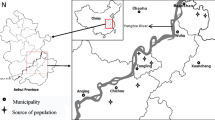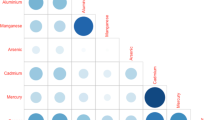Abstract
Although heavy metal pollution has developed into a major global environmental problem, most research has focused on specific elements, especially arsenic (As) and selenium (Se), and on the health risks to people in polluted areas or by occupation. This study investigated the urine of 480 participants from Guangzhou with a population of 18 million and targeted nine heavy metals: As, Se, chromium (Cr), manganese (Mn), nickel (Ni), cadmium (Cd), lead (Pb), antimony (Sb), and mercury (Hg). The heavy metals were widely detected, of which As, Se, Cd, and Pb all exceed 98%. Among the toxicants, As showed the highest concentration, followed by Se with 40.5 and 35.4 μg/L, respectively. The heavy metal levels from suburban subjects were generally higher than those in urban subjects (except for Sb), and the Cd level of males was lower than that of females. Concentrations were related to age, body mass index, alcohol consumption, and smoking. According to the health risk assessment, most subjects experienced potential non-carcinogenic risk from As, Cd, Se, and Hg, which accounted for 38.2%, 8.83%, 8.31%, and 3.38%, respectively. The carcinogenic risk of As and Cd surpassed the risk level of 10−6, and 90.1% and 35.4% of the subjects, respectively, exceeded 10−4, an unacceptable risk level. More attention to the high carcinogenic risk from heavy metals and the high detected levels of As and Cd is required.


Similar content being viewed by others
Availability of data and materials
All data generated or analyzed during this study are included in this published article (and its supplementary information files).
References
Abdul KSM, Jayasinghe SS, Chandana EPS, Jayasumana C, De Silva PMCS (2015) Arsenic and human health effects: a review. Environ Toxicol Pharmacol 40(3):828–846. https://doi.org/10.1016/j.etap.2015.09.016
Awasthi AK, Wang MM, Awasthi MK, Wang ZS, Li JH (2018) Environmental pollution and human body burden from improper recycling of e-waste in China: a short-review. Environ Pollut 243:1310–1316. https://doi.org/10.1016/j.envpol.2018.08.037
BaJaj M, Eiche E, Neumann T, Winter J, Gallert C (2011) Hazardous concentrations of selenium in soil and groundwater in north-west India. J Hazard Mater 189(3):640–646. https://doi.org/10.1016/j.jhazmat.2011.01.086
Boskabady M, Marefati N, Farkhondeh T, Shakeri F, Farshbaf A, Boskabady MH (2018) The effect of environmental lead exposure on human health and the contribution of inflammatory mechanisms, a review. Environ Int 120:404–420. https://doi.org/10.1016/j.envint.2018.08.013
Brima EI, Jenkins RO, Haris PI (2006) Understanding arsenic metabolism through spectroscopic determination of arsenic in human urine. Spectroscopy 20(3):125–151. https://doi.org/10.1155/2006/759046
Brown KM, Arthur JR (2001) Selenium, selenoproteins and human health: a review. Public Health Nutr 4(2b):593–599. https://doi.org/10.1079/PHN2001143
Cai LM, Xu ZC, Ren MZ, Guo QW, Hu XB, Hu GC, Wan HF, Peng PG (2012) Source identification of eight hazardous heavy metals in agricultural soils of Huizhou, Guangdong Province, China. Ecotoxicol Environ Saf 78:2–8. https://doi.org/10.1016/j.ecoenv.2011.07.004
Cao ZJ, Lin SB, Zhao F, Lv YB, Qu YL, Hu XJ, Yu SC, Song SX, Lu YF, Yan HF, Liu YC, Ding L, Zhu Y, Liu L, Zhang M, Wang T, Zhang WL, Fu H, Jin YJ, Cai JY, Zhang X, Yan CH, Ji SS, Zhang ZN, Dai JY, Zhu HJ, Gao LX, Yang YW, Li CC, Zhou JH, Ying B, Zheng L, Kang Q, Hu JM, Zhao WX, Zhang MY, Yu XY, Wu B, Zheng TZ, Liu Y, Ryan PB, Barr DB, Qu WD, Zheng YX, Shi, XM (2021) Cohort profile: China National Human Biomonitoring (CNHBM)-a nationally representative, prospective cohort in Chinese population. Environ Int 146. https://doi.org/10.1016/j.envint.2020.106252
Chen X, Xia XH, Zhao Y, Zhang P (2010) Heavy metal concentrations in roadside soils and correlation with urban traffic in Beijing, China. J Hazard Mater 181:640–646. https://doi.org/10.1016/j.jhazmat.2010.05.060
Chen Y, Fang JZ, Ren L, Fan RF, Zhang JQ, Liu GH, Zhou L, Chen DY, Yu YX, Lu SY (2018) Urinary bisphenol analogues and triclosan in children from south China and implications for human exposure. Environ Pollut 238:299–305. https://doi.org/10.1016/j.envpol.2018.03.031
Chen Y, Jiang L, Lu SY, Kang L, Luo XR, Liu GH, Cui XY, Yu YX (2019) Organophosphate ester and phthalate ester metabolites in urine from primiparas in Shenzhen, China: Implications for health risks. Environ Pollut 247:944–952. https://doi.org/10.1016/j.envpol.2019.01.107
Clarkson TW (1997) The toxicology of mercury. Crit Rev Clin Lab Sci 34(4):369–403. https://doi.org/10.3109/10408369708998098
Cui YJ, Zhong Q, Hu MJ, Sheng J, Yang YY, Liang L, Wang XD, Yang YW, Zhou MM, Huang F (2017) Human biomonitoring of eight trace elements in urine of residents living in rural areas along the Yangtze River. China Environ Sci Pollut Res 24(36):27963–27973. https://doi.org/10.1007/s11356-017-0414-3
Ding CG, Pan YJ, Zhang AH, Wu BH, Huang HL, Zhu C, Liu DY, Zhu BL, Xu G, Shao H, Peng SZ, Jiang XL, Zhao CX, Han CC, Ji HR, Yu SF, Zhang XX, Zhang LL, Zheng YX, Yan HF (2014) Study of distribution and influencing factors of lead and cadmium in whole blood and urine among population in 8 provinces in China. Chin J Prev Med 48(2):91–96 ((in Chinese))
Duzgoren-Aydin NS (2007) Sources and characteristics of lead pollution in the urban environment of Guangzhou. Sci Total Environ 385:182–195. https://doi.org/10.1016/j.scitotenv.2007.06.047
Gallagher CM, Chen JJ, Kovach JS (2011) The relationship between body iron stores and blood and urine cadmium concentrations in US never-smoking, non-pregnant women aged 20–49 years. Environ Res 111(5):702–707. https://doi.org/10.1016/j.envres.2011.03.007
Gu YG, Gao YP (2017) Bioaccessibilities and health implications of heavy metals in exposed-lawn soils from 28 urban parks in the megacity Guangzhou inferred from an in vitro physiologically-based extraction test. Ecotoxicol Environ Saf 148:747–753. https://doi.org/10.1016/j.ecoenv.2017.11.039
Gu YG, Gao YP, Lin Q (2016) Contamination, bioaccessibility and human health risk of heavy metals in exposed-lawn soils from 28 urban parks in southern China’s largest city, Guangzhou. Appl Geochem 67:52–58. https://doi.org/10.1016/j.apgeochem.2016.02.004
Gu YG, Qu SL, Fang JH, He BY, Fu HB, Tong ZJ (2014) Identification of heavy metal sources in the reclaimed farmland soils of the pearl river estuary in China using a multivariate geostatistical approach. Ecotoxicol Environ Saf 105:7–12. https://doi.org/10.1016/j.ecoenv.2014.04.003
Hatfield DL, Tsuji PA, Carlson BA, Gladyshev VN (2014) Selenium and selenocysteine: roles in cancer, health, and development. Trends Biochem Sci 39(3):112–120. https://doi.org/10.1016/j.tibs.2013.12.007
Huang R, Chen ZH, Wang P, Chen SW, Huo WL (2019) Analysis of aquatic products consumption in adults in Guangdong Province, 2015. South Chin J Prev Med 45(3):283–286 ((in Chinese))
Inoue Y, Umezaki M, Jiang HW, Li DD, Du JW, Jin YM, Yang B, Li B, Li YF, Watanabe C (2014) Urinary concentrations of toxic and essential trace elements among rural residents in Hainan Island, China. Int J Environ Res Public Health 11(12):13047–13064. https://doi.org/10.3390/ijerph111213047
Islam MS, Ahmed MK, Raknuzzaman M, Habibullah-Al-Mamun M, Islam MK (2015) Heavy metal pollution in surface water and sediment: a preliminary assessment of an urban river in a developing country. Ecol Indic 48:282–291. https://doi.org/10.1016/j.ecolind.2014.08.016
Järup L, Åkesson A (2009) Current status of cadmium as an environmental health problem. Toxicol Appl Pharmacol 238(3):201–208. https://doi.org/10.1016/j.taap.2009.04.020
Lei BL, Chen L, Hao Y, Cao TH, Zhang XY, Yu YX, Fu JM (2013) Trace elements in animal-based food from Shanghai markets and associated human daily intake and uptake estimation considering bioaccessibility. Ecotoxicol Environ Saf 96:160–167. https://doi.org/10.1016/j.ecoenv.2013.06.032
Lei BL, Zhang KQ, An J, Zhang XY, Yu YX (2015) Human health risk assessment of multiple contaminants due to consumption of animal-based foods available in the markets of Shanghai. China Environ Sci Pollut Res 22(6):4434–4446. https://doi.org/10.1007/s11356-014-3683-0
Liang X, Ning XA, Chen GX, Lin MQ, Liu JY, Wang YJ (2013) Concentrations and speciation of heavy metals in sludge from nine textile dyeing plants. Ecotoxicol Environ Saf 98:128–134. https://doi.org/10.1016/j.ecoenv.2013.09.012
Liu XM, Song QJ, Tang Y, Li WL, Xu JM, Wu JJ, Wang F, Brookes PC (2013) Human health risk assessment of heavy metals in soil-vegetable system: a multi-medium analysis. Sci Total Environ 463:530–540. https://doi.org/10.1016/j.scitotenv.2013.06.064
Liu XY, Li PX, Lin XZ, Gan ZW, Hou L (2020) Concentration of heavy metals and ratios of lead isotope inhuman whole blood and urine from Chengdu. J Sichuan University 57(4):774–780 ((in Chinese))
Lu Y, Yin W, Huang LB, Zhang GL, Zhao YG (2011) Assessment of bioaccessibility and exposure risk of arsenic and lead in urban soils of Guangzhou City. China Environ Geochem Health 33(2):93–102. https://doi.org/10.1007/s10653-010-9324-8
Ma L, Wang L, Tang J, Yang ZG (2017) Arsenic speciation and heavy metal distribution in polished rice grown in Guangdong Province, Southern China. Food Chem 233:110–116. https://doi.org/10.1016/j.foodchem.2017.04.097
Marchiset-Ferlay N, Savanovitch C, Sauvant-Rochat MP (2012) What is the best biomarker to assess arsenic exposure via drinking water? Environ Int 39(1):150–171. https://doi.org/10.1016/j.envint.2011.07.015
Men C, Liu RM, Xu F, Wang QR, Guo LJ, Shen ZY (2018) Pollution characteristics, risk assessment, and source apportionment of heavy metals in road dust in Beijing, China. Sci Total Environ 612:138–147. https://doi.org/10.1016/j.scitotenv.2017.08.123
Mortada WI, Sobh MA, El-Defrawy MM, Farahat SE (2002) Reference intervals of cadmium, lead, and mercury in blood, urine, hair, and nails among residents in Mansoura city, Nile delta. Egypt Environ Res 90(2):104–110. https://doi.org/10.1006/enrs.2002.4396
Peng MM, Lu SY, Yu YX, Liu S, Zhao Y, Li C, Ma ST (2020) Urinary monohydroxylated polycyclic aromatic hydrocarbons in primiparas from Shenzhen, South China: Levels, risk factors, and oxidative stress. Environ Pollut 259. https://doi.org/10.1016/j.envpol.2019.113854
Rayman MP (2012) Selenium and human health. Lancet 379(9822):1256–1268. https://doi.org/10.1016/S0140-6736(11)61452-9
Ronteltap M, Maurer M, Gujer W (2007) The behaviour of pharmaceuticals and heavy metals during struvite precipitation in urine. Water Res 41(9):1859–1868. https://doi.org/10.1016/j.watres.2007.01.026
Sarvestani RA, Aghasi M (2019) Health risk assessment of heavy metals exposure (lead, cadmium, and copper) through drinking water consumption in Kerman city, Iran. Environ Earth Sci 78(24). https://doi.org/10.1007/s12665-019-8723-0
Satarug S, Moore MR (2004) Adverse health effects of chronic exposure to low-level cadmium in foodstuffs and cigarette smoke. Environ Health Perspect 112(10):1099–1103. https://doi.org/10.1289/ehp.6751
Shang ST, Zhong W, Wei ZQ, Zhu C, Ye SS, Tang XW, Chen Y, Tian LX, Chen B (2017) Heavy metals in surface sediments of lakes in Guangzhou public parks in China and their relations with anthropogenic activities and urbanization. Hum Ecol Risk Assess 23(8):2002–2016. https://doi.org/10.1080/10807039.2017.1358078
Shen MN, Kang CY, Song TH, Lu H, Wang YH, Yu BW, Wang R, Cheng J (2020) Content and health risk assessment of heavy metals and polybrominated diphenyl ethers in fish from Songhua Lake (Jilin City). China Environ Sci Pollut Res 27(32):40848–40856. https://doi.org/10.1007/s11356-020-10067-w
Tan LC, Nancharaiah YV, van Hullebusch ED, Lens PNL (2016) Selenium: environmental significance, pollution, and biological treatment technologies. Biotechnol Adv 34(5):886–907. https://doi.org/10.1016/j.biotechadv.2016.05.005
Tan QY, Ma JX, Zhou M, Wang DM, Wang B, Nie XQ, Mu G, Zhang XM, Chen WH (2020) Heavy metals exposure, lipid peroxidation and heart rate variability alteration: association and mediation analyses in urban adults. Ecotoxicol Environ Saf 205. https://doi.org/10.1016/j.ecoenv.2020.111149
Tang XJ, Shen CF, Shi DZ, Cheema SA, Khan MI, Zhang CK, Chen YX (2010) Heavy metal and persistent organic compound contamination in soil from Wenling: an emerging e-waste recycling city in Taizhou area, China. J Hazard Mater 173:653–660. https://doi.org/10.1016/j.jhazmat.2009.08.134
Tchounwou PB, Patlolla AK, Centeno JA (2003) Carcinogenic and systemic health effects associated with arsenic exposure-a critical review. Toxicol Pathol 31(6):575–588. https://doi.org/10.1080/01926230390242007
Todorov TI, Ejnik JW, Mullick FG, Centeno JA (2005) Arsenic speciation in urine and blood reference materials. Microchim Acta 151:263–268. https://doi.org/10.1007/s00604-005-0414-8
USEPA (2001) Risk assessment guidance for superfund: volume III-part A, process for conducting probabilistic risk assessment. Environmental Protection Agency Washington, DC 20460
USEPA (2010) Arsenic, inorganic EPA/635/R-10/001. Washington, DC
Vimercati L, Gatti MF, Gagliardi T, Cuccaro F, De Maria L, Caputi A, Quarato M, Baldassarre A (2017) Environmental exposure to arsenic and chromium in an industrial area. Environ Sci Pollut Res 24(12):11528–11535. https://doi.org/10.1007/s11356-017-8827-6
Virani S, Rentschler KM, Nishijo M, Ruangyuttikarn W, Swaddiwudhipong W, Basu N, Rozek LS (2016) DNA methylation is differentially associated with environmental cadmium exposure based on sex and smoking status. Chemosphere 145:284–290. https://doi.org/10.1016/j.chemosphere.2015.10.123
Wang JQ, Qian R, Wang YD, Dong MR, Liu X, Zhou H, Ye YF, Chen GM, Chen DZ, Yuan LX, Xiao JP, He GH, Hu JX, Zeng WL, Rong ZH, Zhang QQ, Zhou MY, Jin J, Fan JJ, Sun JF, Ma WJ, Zhang B, Liu T (2021) The mediation effect of placental weight change in the association between prenatal exposure to selenium and birth weight: evidence from a prospective birth cohort study in China. Environmental Epidemiology 5(2):e139. https://doi.org/10.1097/EE9.0000000000000139
Wang XY, Jin PY, Zhou Q, Liu SN, Wang F, Xi SH (2018) Metal biomonitoring and comparative assessment in urine of workers in lead-zinc and steel-iron mining and smelting. Biol Trace Elem Res 189(1):1–9. https://doi.org/10.1007/s12011-018-1449-0
Wei XL, He JR, Cen YL, Su Y, Chen LJ, Lin Y, Wu BH, Su FX, Tang LY, Ren ZF (2015) Modified effect of urinary cadmium on breast cancer risk by selenium. Clin Chim Acta 438:80–85. https://doi.org/10.1016/j.cca.2014.08.014
White AJ, O’Brien KM, Jackson BP, Karagas MR (2018) Urine and toenail cadmium levels in pregnant women: a reliability study. Environ Int 118:86–91. https://doi.org/10.1016/j.envint.2018.05.030
Wu YKT, Zhang HM, Liu GH, Zhang JQ, Wang JZ, Yu YX, Lu SY (2016) Concentrations and health risk assessment of trace elements in animal-derived food in southern China. Chemosphere 144:564–570. https://doi.org/10.1016/j.chemosphere.2015.09.005
Xiao L, Wang YL, Yu Y, Fu GY, Liu Y, Sun Z, Ye SF (2019) Enhanced selective recovery of selenium from anode slime using MnO2 in dilute H2SO4 solution as oxidant. J Clean Prod 209:494–504. https://doi.org/10.1016/j.jclepro.2018.10.144
Xiao Q, Zong YT, Lu SG (2015) Assessment of heavy metal pollution and human health risk in urban soils of steel industrial city (Anshan), Liaoning, Northeast China. Ecotoxicol Environ Saf 120:377–385. https://doi.org/10.1016/j.ecoenv.2015.06.019
Yamashita Y, Yamashita M, Iida H (2013) Selenium content in seafood in Japan. Nutrients 5(2):388–395. https://doi.org/10.3390/nu5020388
Yu GH, Wen YM, He SY, Zhang L, Dong HY (2007) Food selenium content and resident daily selenium intake in Guangzhou city. J Appl Ecol 18(11):2600 (in Chinese)
Zeng HL, Li CWB, Lu J, Wang X, Cheng LM (2019) Analysis of urinary trace element levels in general population of Wuhan in central China. Environ Sci Pollut Res 26(27):27823–27831. https://doi.org/10.1007/s11356-019-05973-7
Zhao YP, Wu R, Cui JL, Gan SC, Pan JC, Guo PR (2020) Improvement of water quality in the Pearl River Estuary, China: a long-term (2008–2017) case study of temporal-spatial variation, source identification and ecological risk of heavy metals in surface water of Guangzhou. Environ Sci Pollut Res 27(17):21084–21097. https://doi.org/10.1007/s11356-020-08378-z
Funding
This study was supported by General Guidance Project of Health Science and Technology in Guangzhou (20191A011052 and 20211A011062), the National Natural Science Foundation of China (41977303), National Key R&D Program of China (2018YFC1801105), and Guangzhou Center for Disease Control and Prevention, and 100 Talents Program of Guangdong University of Technology.
Author information
Authors and Affiliations
Contributions
Zijuan Zhong: data analysis and draft preparation; Qin Li: methodology; Chongshan Guo: methodology; Yi Zhong: methodology; Jinhua Zhou: methodology; Xiaotong Li: sample collection; Dedong Wang: sample collection and design; Yingxin Yu: design, writing, reviewing, and editing.
Corresponding author
Ethics declarations
Ethics approval
This study was carried out with the approval of the Ethics Committee of Guangdong University of Technology.
Consent to participate
All donors involved in this study signed an informed consent form before the sample collection.
Consent for publication
All donors agreed with the publication of related research results.
Competing interests
The authors declare no competing interests.
Additional information
Responsible Editor: Lotfi Aleya
Publisher's Note
Springer Nature remains neutral with regard to jurisdictional claims in published maps and institutional affiliations.
Supplementary Information
Below is the link to the electronic supplementary material.
Rights and permissions
About this article
Cite this article
Zhong, Z., Li, Q., Guo, C. et al. Urinary heavy metals in residents from a typical city in South China: human exposure and health risks. Environ Sci Pollut Res 29, 15827–15837 (2022). https://doi.org/10.1007/s11356-021-16954-0
Received:
Accepted:
Published:
Issue Date:
DOI: https://doi.org/10.1007/s11356-021-16954-0




